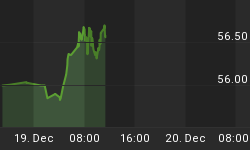Treasuries are trading mixed this morning. There is slight pressure on the June Bonds while June Notes are flat. Growing confidence in the global economy is encouraging investors to forego the relative safety of the U.S. debt market for higher yields in other asset classes.
The Federal Reserve will be buying debt this morning in conjunction with its long-term quantitative easing plan. This is expected to ease any sudden spike in interest rates. Tomorrow the Treasury will announce the size of next week's two, five and seven year debt auction. The combination of these two events is helping to hold Treasury futures in a range.
June T-Notes have retraced its recent range of 119'22 to 122'02. This retracement zone is 120'28 to 120'19. Regaining 120'28 will be a sign of strength.
June T-Bonds are holding inside its retracement zone at 121'19 to 121'03. This is providing some stability to the market this morning.
Depending on how investors feel today about the prospects of an economic recovery, it is possible that the Notes and Bonds can launch the start of a counter-trend rally from both of these retracement areas.
Equity markets remain in an uptrend but upside momentum seems to be slowing as traders await fresh news to give these markets a catalyst to drive stocks to new highs for the year. The best way to describe the current trading action is range bound. The recent trending market has turned into a trading market with short-term traders playing both sides of the market.
It looks as if traders have too much to digest at this time. Auto maker bankruptcies, bank capitalization issues, and a weak housing market are being weighed against reports of improving investor optimism.
Volatility in the stock markets has fallen to levels not seen since the Lehman failure last September. This means that traders feel that markets are no longer susceptible to a meltdown. While this may look good on the surface, investors have to be careful not to get too complacent as conditions can turn fast. If anything, low volatility may mean the markets will become range bound. While excessive volatility may cause headaches for investors, a sideways market can also lead to frustration. From a longer-term perspective, a flat market accompanied with rising Treasury yields may cause investors to shift money back to fixed income instruments in order to lock in a guaranteed yield.
The U.S. Dollar continues to get pounded by foreign investors. Money that had been parked in the Dollar for protection is leaving as traders become more optimistic about a recovery in the global economy. At this time, foreign investors are being driven by speculation that an economic recovery is in the works. Most traders are treating negative economic reports as old news and banking on future improvements.
Investors have to be cautious not to drive currencies too high, too fast. Both the U.K. and Euro Zone central banks have recently warned that the recovery will be slow. Investors have to be concerned about becoming too optimistic about a recovery. If prices rise too fast then bullish currency traders will face exposure to a sizeable correction.
June Gold traders have to be careful adding to current long positions as this market approaches an important retracement price at 937.40. This market has been rallying for thirteen days from the 880.10 low on April 30 without a sizeable correction. Long traders may decide to take profits at 937.40. This may trigger a correction back to 900.00.
July Silver is nearing the high for the year at 14.64. Rallies have been labored lately which is an indication that prices may be too high at current levels. Without a strong case for inflation, traders may lighten up at current levels in an attempt to break this market to more acceptable price levels.
July Soybeans continue to remain strong as bullish fundamentals are driving this market to its next objective at 12.23. This market has been supported by forecasts of low inventory numbers and increased demand from China. Supply and demand conditions have set up the possibility of a runaway bull market if weather conditions develop.
Longer-term sugar traders have to be patient with this market. With demand predicted to outstrip supply this year, conditions are ripe for a bull market, but traders have to be careful not to chase this market.
It is widely known that India has been aggressively buying sugar in the open market to help fulfill its needs, but even they know that excessive speculation has driven prices up too high. The bullish conditions are not going to go away overnight, but traders have to be patient enough to let this market come to them.















